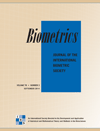
Estimating Peer Effects in Longitudinal Dyadic Data Using Instrumental Variables
Abstract
The identification of causal peer effects (also known as social contagion or induction) from observational data in social networks is challenged by two distinct sources of bias: latent homophily and unobserved confounding. In this paper, we investigate how causal peer effects of traits and behaviors can be identified using genes (or other structurally isomorphic variables) as instrumental variables (IV) in a large set of data generating models with homophily and confounding. We use directed acyclic graphs to represent these models and employ multiple IV strategies and report three main identification results. First, using a single fixed gene (or allele) as an IV will generally fail to identify peer effects if the gene affects past values of the treatment. Second, multiple fixed genes/alleles, or, more promisingly, time-varying gene expression, can identify peer effects if we instrument exclusion violations as well as the focal treatment. Third, we show that IV identification of peer effects remains possible even under multiple complications often regarded as lethal for IV identification of intra-individual effects, such as pleiotropy on observables and unobservables, homophily on past phenotype, past and ongoing homophily on genotype, inter-phenotype peer effects, population stratification, gene expression that is endogenous to past phenotype and past gene expression, and others. We apply our identification results to estimating peer effects of body mass index (BMI) among friends and spouses in the Framingham Heart Study. Results suggest a positive causal peer effect of BMI between friends.
Citation:
A.J. O’Malley, F. Elwert, J.N. Rosenquist, A.M. Zaslavsky, and N.A. Christakis, "Estimating Peer Effects in Longitudinal Dyadic Data Using Instrumental Variables" Biometrics, 70: 506-515 (April, 2014) doi: 10.1111/biom.12172